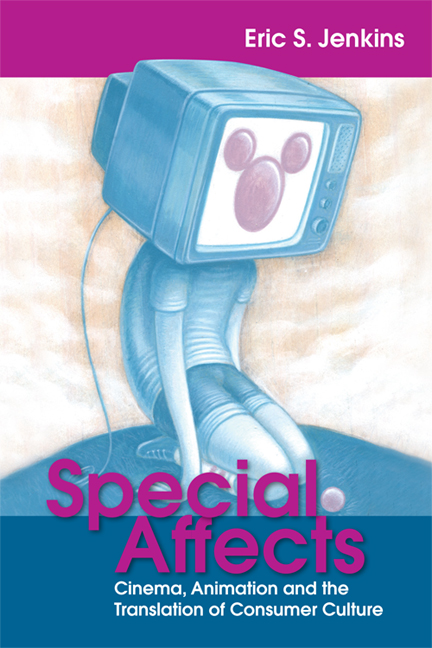Book contents
- Frontmatter
- Contents
- Acknowledgements
- List of Illustrations
- 1 Introduction
- 2 Astonishment and the Fantastic in Live-Action Cinema
- 3 Say Cheese! The Cinematic Lifestyle Consumer
- 4 Animation's Marvel and the Graphic Narrative Mode
- 5 Of Mice and Mimesis: The Wondrous Spark of Disney
- 6 Mutual Affection-Images and Daydreaming Consumers
- 7 The Disney Version of the American Dream
- 8 Walt and Wall-E in Control Society
- Movies Referenced in Special Affects
- Notes
- Index
2 - Astonishment and the Fantastic in Live-Action Cinema
Published online by Cambridge University Press: 05 August 2016
- Frontmatter
- Contents
- Acknowledgements
- List of Illustrations
- 1 Introduction
- 2 Astonishment and the Fantastic in Live-Action Cinema
- 3 Say Cheese! The Cinematic Lifestyle Consumer
- 4 Animation's Marvel and the Graphic Narrative Mode
- 5 Of Mice and Mimesis: The Wondrous Spark of Disney
- 6 Mutual Affection-Images and Daydreaming Consumers
- 7 The Disney Version of the American Dream
- 8 Walt and Wall-E in Control Society
- Movies Referenced in Special Affects
- Notes
- Index
Summary
By the time of Disney's 1930s and 1940s full-length features, live-action film had become the feature attraction. Mickey, Felix the Cat and other animated stars received face time on the silver screen only as seven-minute shorts tacked on to the features. They ran alongside newsreels, previews and other acts on the ‘film bill’. The film bill harkened back to an earlier time in cinema history beginning just twenty-five years prior, an era Tom Gunning bills as the ‘cinema of attractions’. The cinema of attractions describes a pre-classical film practice located in the vaudeville stage and travelling shows, not the nickelodeons (5-cent theatres) and Hollywood studios of classical cinema. At these shows, audiences witnessed a performance featuring a series of attractions, each seeking to produce ‘peak’ or ‘aggressive moments’ generating the ‘shock’ or ‘astonishment’ central to the attraction's attraction. Attractions were not limited to reproducible media; music, comedy, live performances, animated images, live-action films and many other attractions shared the same stage and competed for attention.
By the time of Disney's full-length features, however, the classical cinema dominated. Movie theatres dotted the globe, with fifty million watching motion pictures weekly in the United States, equivalent to onehalf of the population. Studios had established institutional roots, big budgets and industrial production methods. Film had produced its first recognisable auteurs and stars, and birthed its first mature mode, the classical mode. As a result, almost every other cultural form felt an irresistible pull to become more cinematic, including painting, novels, theatre and animation. Hollywood had developed a mode that would significantly shape American culture as well as transforming the consumer and commodity. From the perspective of 1929, it indeed seemed that cinema embodied the essence of modern consumer culture and that animation would remain a silly sideshow, a mere footnote easily ignored or readily incorporated into analyses stressing Hollywood's dominance.
Hollywood's influence explains why we will spend this chapter, in a book about animation, detailing the translation of the cinema of attractions into classical cinema. Disney's animistic mimesis translates the classical mode, emerging in a context where live-action drove studio imperatives and had repeatedly attracted audiences. A quick word on the concept of translation is necessary.
- Type
- Chapter
- Information
- Special AffectsCinema, Animation and the Translation of Consumer Culture, pp. 27 - 58Publisher: Edinburgh University PressPrint publication year: 2014



